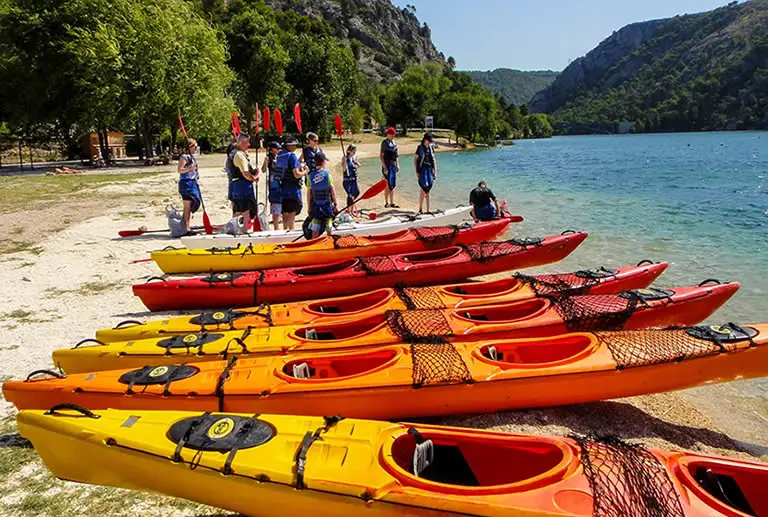Contents
What Is A Kayak & Why Are There Different Types?
A kayak is a small one to four person personal watercraft that is propelled by a double-bladed paddle.
There are 6 different categories of modern kayak that range from sea kayaks to racing kayaks.
Kayaks also come in 4 different hulls designs with focus placed on primary and secondary stability features.
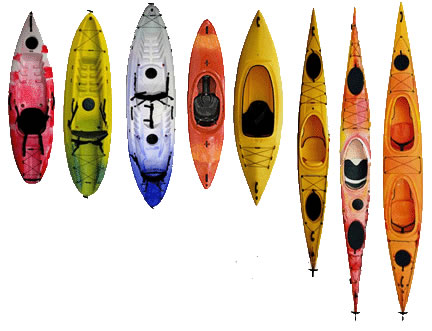
A kayak is a small vessel that resembles a canoe but that has some design differences and is also propelled differently.
A kayak is manually propelled via the aid of a double-bladed paddle.
A traditionally-styled kayak will have a covered deck with one or more cockpits (openings) designed for the paddler to sit in.
A spray deck, also called a spray skirt, is often used to cover the cockpit.
This spray deck effectively closes off the cockpit to prevent the entry of water from waves or spray.
Spray decks can be made from a variety of different waterproof cloth materials.
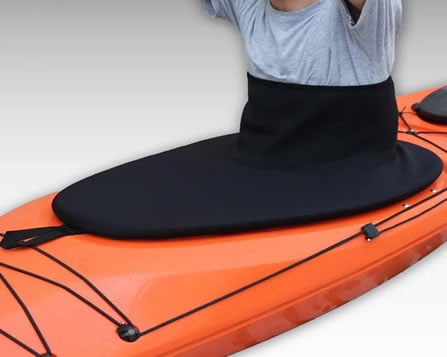
A spray deck allows a kayaker to roll the kayak.
Rolling a kayak involves deliberately turning the vessel upside down effectively capsizing it, before completing the turn and righting the boat in the opposite direction.
This rolls the boat 360 degrees in the water.
As the cockpit is watertight, due to the spray deck, the vessel takes on no water.
To complete the roll the kayaker rolls the vessel back right-side-up with his/her continuing momentum.
It is important to know how to roll a kayak so you can right yourself if you accidently capsize.
If you want to know how to roll a kayak follow the instructions in the video below.
Different Kayak Hulls & How They Affect Performance
Although many modern kayaks may look very similar there are a variety of different designs suited to very specific uses.
Modern kayaks are usually split into 6 different categories based on their use.
Below is a list of the applications used to categorize modern kayaks:
- Sea and touring kayaks.
- Whitewater/river kayaks.
- Surf kayaks.
- Fishing kayaks.
- Recreational kayaks.
- Racing kayaks.
Before we look at these different types of kayaks and their designs it is important to cover the topic of stability and how it is affected by hull design.
Kayak hull types & their best uses
Below are quick descriptions of each of the 4 basic hull designs that you will see on standard modern kayaks.

To understand how these hull designs affect a kayak we will look at them a little more closely.
Flat-bottomed hulls
Flat-bottomed hull kayaks are very popular because they can be used for a wide range of purposes.
The flat bottom design means they can be used in very shallow waters and in calm conditions they offer great stability and good manoeuvrability.
Many recreational kayaks and fishing kayaks use this hull design because of its superior primary stability.
Rounded Hulls
A kayak with a rounded hull offers much more speed in the water due to it encountering less water resistance.
This rounded hull design may offer more speed but it comes at the cost of less primary stability.
They tend to feel very tippy even in very calm water.
A rounded hull does offer exceptional manoeuvrability though and reduces the risk of capsizing in turbulent waters.
V-Shaped Hulls
A kayak with a v-shaped is better equipped to cut through water.
A v-shaped hull will be most common design used for kayaks taken into the sea.
Though, as you will see later the design needs to be changed slightly for fishing in the ocean.
Pontoon Hulls
A kayak with a pontoon hull is the most stable of all the kayak designs though this exceptional stability comes at the price of speed.
This great stability comes from a design that incorporates the primary stability of a flat hull with the added secondary stability of a rounded hull.
What does the above sentence mean? Well let’s have a look.
How Different Primary & Secondary Stability Characteristics Are Used In Kayak Designs
It isn’t just the basic hull design that determines how a kayak performs in water.
The primary and secondary stability of a kayak are based on how the vessel curves at the sides and how it curves, or doesn’t curve, on the bottom of the hull.
Below is a simplistic explanation of what primary and secondary stability are but it is accurate enough to give you an understanding of how these two factors affect the boat.
Primary stability is the stability of the kayak on the calm water.
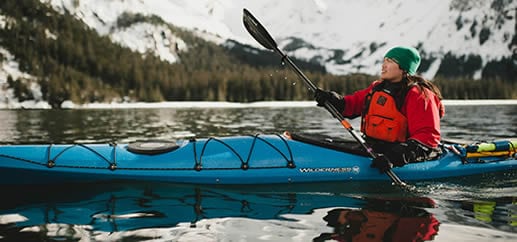
Secondary stability is the kayak’s ability to stay stable when rocked by waves.
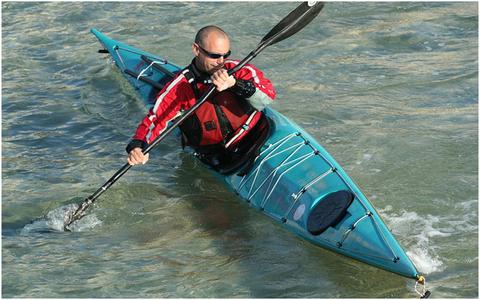
The Primary and secondary stability of a kayak is determined by:
- The chine: the curve on the bottom of the kayak.
- The Rocker: the curve at the sides of the kayak.
The amount of curve in these two areas will determine how stable the kayak is.
The 3 types of Chine
The chine is determined by the amount of curve there is between the lower sides of the vessel and its bottom.
Hard Chine
A hard chine, as you can see on a flat-bottomed kayak, is less rounded and more angular in appearance.
Soft Chine
A soft chine, like you’d see on a rounded hull kayak, is more rounded in appearance.
Multi-chine
Multi-chine hulls are an attempt by manufacturers to create more stable kayaks that work well for different applications.
Such kayaks will have a hull design that has elements of both hard chine and soft chine attributes.
These boats are considered to be multi-chined or multiple chine kayaks.
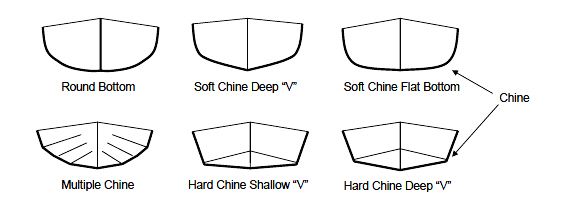
Why it’s important to have different Rocker characteristics on different boats
The rocker refers to the roundness of the boat.
This greatly affects the stability of the kayak in challenging conditions.
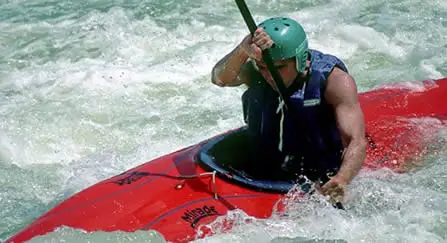
The more roundness (rocker) a kayak has the better it is at handling turbulent water.
A kayak with good rocker is better in marine environments where the boat is rocked from side to side – such as in rough sea conditions, turbulent rapids or bad weather.
6 Types Of Popular Kayaks
Now that you understand how primary and secondary stability is affected by a kayak’s design you are in a better position to understand why the design concepts are important.
You will see how the different design characteristics of the 6 different types of kayak, make each kayak better suited to a specific application and environment.
Sea and touring kayaks
Not all kayaks are seaworthy.
So, to have a vessel that is capable of handling the type of challenging waters that the ocean produces a sea kayak must have a unique design.
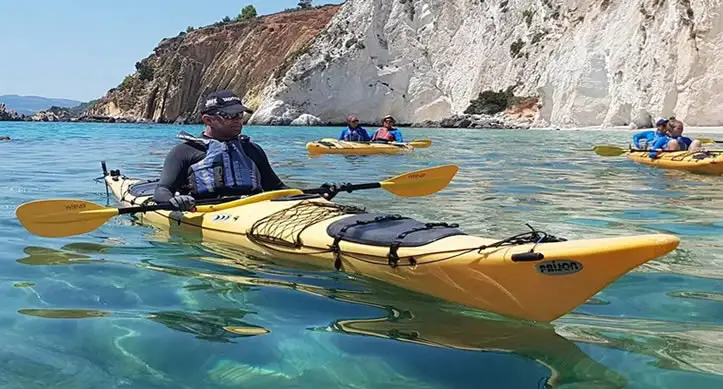
A kayak that is seaworthy must have good secondary stability because it will be jostled about on waves along with good primary stability for long periods paddling.
Most sea kayaks measure from 12ft to 24ft in length.
The larger vessels are usually designed to carry two people though many modern ones are capable of carrying three.
These kayaks are usually made from of fiberglass, or rotomolded polyethylene, or thermoformed plastic, or blow molded polyethylene or carbon-kevlar.
Although most touring kayaks will be store-bought you will see handmade kayaks on the ocean.
Handmade kayaks, like home-built Jon boats, are usually constructed from plywood strips.
Unlike home-built Jon boats though a plywood kayak will be covered with a layer of fiberglass for added protection.
Whitewater or river kayaks
Whitewater kayaks are often called river kayaks, however they should not be confused with recreational kayaks that are used on calm rivers that have little to no turbulence.
These type of kayaks are designed for rivers that have rapids and other areas of turbulent water.
In calm rivers you are more likely to see recreational kayaks.
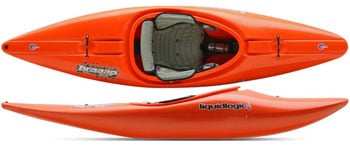
Whitewater river kayaks are designed to take abuse.
Most river and whitewater kayaks are constructed from hard plastic because they tend to get knocked around quite a lot.
The hull tends to be rounded and they have a soft chine though some beginner boats will have a harder chine for easier handling.
They have lots of rocker because, let’s face it, they need it!
Surf kayaks
A surf kayak has many design similarities to a surfboard with some boats being fitted with fins, like a surfboard, to help them ride the waves.
A surf kayak is very distinctive and has its own particular look that sets it apart from other kayaks.
It has an upturned nose at the bow and a sleek downward facing stern.
These kayaks also tend to be short in length.
Whitewater kayaks are also often used in kayak surfing because they also have great secondary stability.
Fishing kayaks
Some fishing kayaks almost resemble mini Jon boats.
Fishing kayaks will have an open cockpit but the actual hull design used will depend upon the environment in which the angler intends to fish.
In calm rivers and inland lakes a flat bottom hull offers great primary stability and a very easy platform to fish off.
However, this hull design would be insufficient for ocean use.
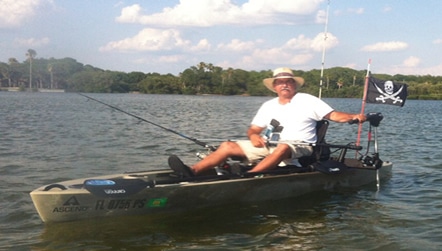
It could actually be dangerous to use in the sea due to its bad secondary stability and its inability to ride rough water.
So, a kayak designed for coastal fishing will have a trade-off between adequate primary stability, which is needed to fish, with good secondary stability that is needed to handle choppy waters.
Recreational kayaks
Recreational kayaks come in all types and slightly different designs.
The flat-bottomed kayak is probably the most widely used recreational vessel, as most kayak playtime is spent in calm rivers, streams and lakes.
The flat-bottomed hull offers exceptional stability in calm water and is thus a favorite for family use.
Most recreational kayaks are long with vessels made for single-person or 2-person use.
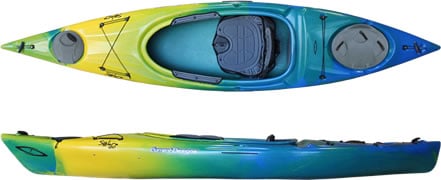
Flat bottom recreational kayaks are almost always the boat of choice for beginners.
However, as I have stated many times on this website, just because a flat bottom kayak is the best choice for a beginner that does not make it a beginner boat.
It just happens to be the most stable boat in calm waters and therefore is great for beginners.
Many experienced kayakers love their flat bottom kayaks.
I covered the many benefits of using this type of recreational kayak in the article Why Choose a Flat Bottom Kayak.
Racing kayaks
Racing kayaks are used mostly for water marathons and sprints. So they need to be fast.
But racing kayaks are also used for river racing where there are weirs as well as turbulent water. So, these boats can’t completely substitute speed for stability.
They need a certain amount of both.
In kayak racing single boats are referred to as K1s. Doubles as K2’s and four man boats as K4’s.
Because a kayak’s speed is determined by its length and width, when it comes to competitive racing each kayak must adhere to strict international regulations on boat length if they wish to compete.
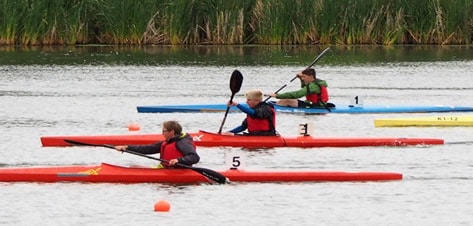
Minimum weights for the boats are also set.
K1’s are permitted to be a maximum of 5.2 m in length and must weigh at least 12 kg for sprint racing and 8 kg for marathon racing.
K2s are permitted to be a maximum of 6.5 m in length and must weigh at least 18 kg for sprint racing and 12 kg for marathon racing.
K4’s are permitted to be a maximum of 11 m and must weigh at least 30 kg for sprint racing.
Sprint boats use rudders which are located about 18” from the stern which are accessed through a rudder hatch set into the boat.
To ensure a fast speed can be reached and maintained these boats are made as streamlined as possible with the least amount of flexing and deforming occurring with use.
To ensure a racing boat remains as stiff as possible carbon is often incorporated into the construction to lend the boat a strong rigid finish.
This tough, but lightweight material, means the boat will usually weigh in at just under the minimum weight requirements needed to race.
So, additional weights are then added to meet the requirements.
When it comes to marathon races kayaks need to be more stable on washes. They must be able to cruise at high speeds and turn well while being able to sprint at speed when the need arises.
They are not much different from sprint kayaks with many racers alternating between the two.
History Of The Kayak
Kayaks were the invention of the people indigenous to the arctic regions called the Inuit, often referred to as Eskimos by outsiders (though this term more accurately refers to many different races including Native Americans).
The very first kayaks were constructed from wooden frames that were covered in sealskin to make them waterproof.
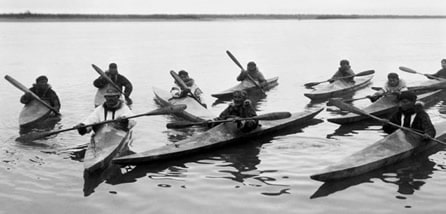
Like modern sit-in kayaks the Intuits would sit in a cockpit in the center of the boat and propel and steer it with a paddle.
They used kayaks mostly for hunting.
The first modern kayaks followed the original Inuit design though with European expansion across the American continent the traditional skin that covered the boat was slowly replaced with fabric.
In the 1950s fabric was replaced by fiberglass as the covering of choice before plastic began being readily available in 1984.

